key CHEVROLET TRACKER 1998 1.G Owners Manual
[x] Cancel search | Manufacturer: CHEVROLET, Model Year: 1998, Model line: TRACKER, Model: CHEVROLET TRACKER 1998 1.GPages: 386, PDF Size: 21.17 MB
Page 32 of 386
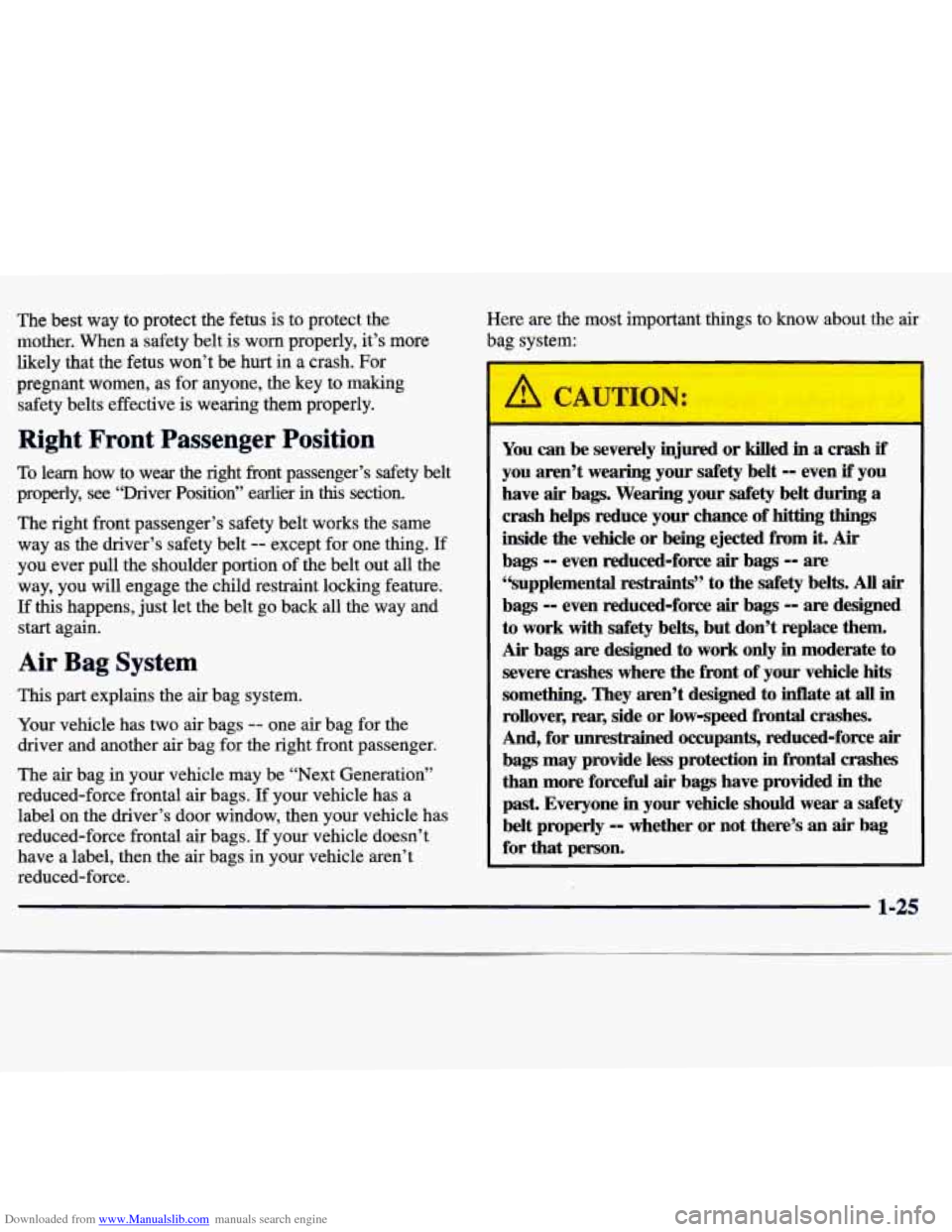
Downloaded from www.Manualslib.com manuals search engine The best way to protect the fetus is to protect the
mother. When
a safety belt is worn properly, it’s more
likely that the fetus won’t be hurt in a crash. For
pregnant women, as for anyone, the key
to making
safety belts effective
is wearing them properly.
Right Front Passenger Position
To learn how to wear the right front passenger’s safety belt
properly,
see “Driver Position” earlier in this section.
The right front passenger’s safety belt works the same
way as
the driver’s safety belt -- except for one thing. If
you ever pull the shoulder portion of the belt out all the
way, you will engage the child restraint locking feature.
If this happens, just let the belt go back all the way and
start again.
Air Bag System
This part explains the air bag system.
Your vehicle has two air bags
-- one air bag for the
driver and another air bag for the right front passenger.
The air bag in your vehicle may be “Next Generation”
reduced-force frontal ak bags. If your vehicle has a
label on the driver’s door window, then your vehicle has
reduced-force frontal air bags. If your vehicle doesn’t
have a label, then the
air bags in your vehicle aren’t
reduced-force. Here
are the
most important things to know about the air
bag system:
You can be severely injured or killed in a crash if
you aren’t wearing your safety belt -- even if you
have
air bags. Wearing your safety belt during a
crash helps reduce your chance of bitting
things
inside the vehicle or being ejected from it. Air
bags -- even reduced-force air bags -- are
“supplemental restraints” to the safety belts. All air
bags -- even reduced-force air bags -- are designed
to work with safety belts, but don’t replace them.
Air bags are designed to work only in moderate to
severe crashes where the front of your vehicle hits
something. They aren’t designed to Mate at all in
rollover, rear, side or low-speed frontal crashes.
And, for
unrestrained occupants, reduced-force air
bags may provide less protection in frontal crashes
than more forcefid
air bags have provided in the
past. Everyone
in your vehicle should wear a safety
belt properly
-- whether or not there’s an air bag
for that person.
1-25
Page 38 of 386
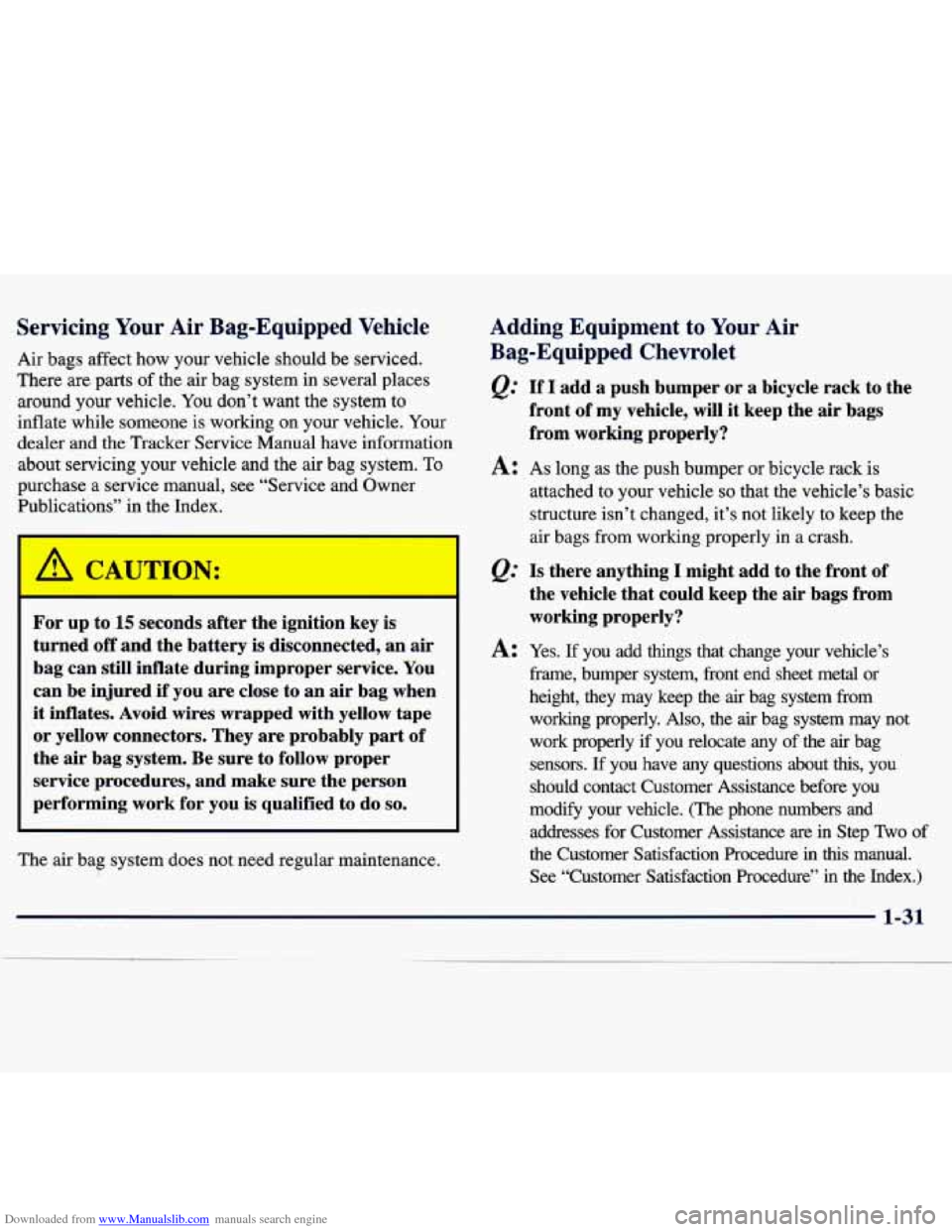
Downloaded from www.Manualslib.com manuals search engine Servicing Your Air Bag-Equipped Vehicle
Air bags affect how your vehicle should be serviced.
There are parts of the air bag system in several places
around
your vehicle. You don’t want the system to
inflate while someone is working on your vehicle. Your
dealer and the Tracker Service Manual have information
about servicing your vehicle and the air bag system.
To
purchase a service manual, see “Service and Owner
Publications” in the Index.
I
For up to 15 seconds after the ignition key is
turned
off and the battery is disconnected, an air
bag can still inflate during improper service. You
can be injured if you are close to an air bag when
it inflates. Avoid wires wrapped with yellow tape
or yellow connectors. They are probably part of
the air bag system. Be sure to follow proper
service procedures, and make sure the person
performing work for you is qualified to do
so.
The air bag system does not need regular maintenance. I
Adding Equipment to Your Air
Bag-Equipped Chevrolet
@ If I add a push bumper or a bicycle rack to the
front
of my vehicle, will it keep the air bags
from working properly?
A: As long as the push bumper or bicycle rack is
attached to your vehicle
so that the vehicle’s basic
structure isn’t changed, it’s not likely to keep the
air bags from working properly in
a crash.
@ Is there anything I might add to the front of
the vehicle that could keep the air bags from
working properly?
A: Yes. If you add things that change your vehicle’s
fi-ame, bumper system, fiont end sheet metal or
height, they may keep the
air bag system from
working properly.
Also, the air bag system may not
work properly if you relocate
any of the air bag
sensors.
If you have any questions about this, you
should contact Customer Assistance before you
modify
your vehicle. (The phone numbers and
addresses for Customer Assistance are in Step Two
of
the Customer Satisfaction Procedure in this manual.
See “Customer Satisfaction Procedure” in the Index.)
1-31
Page 60 of 386
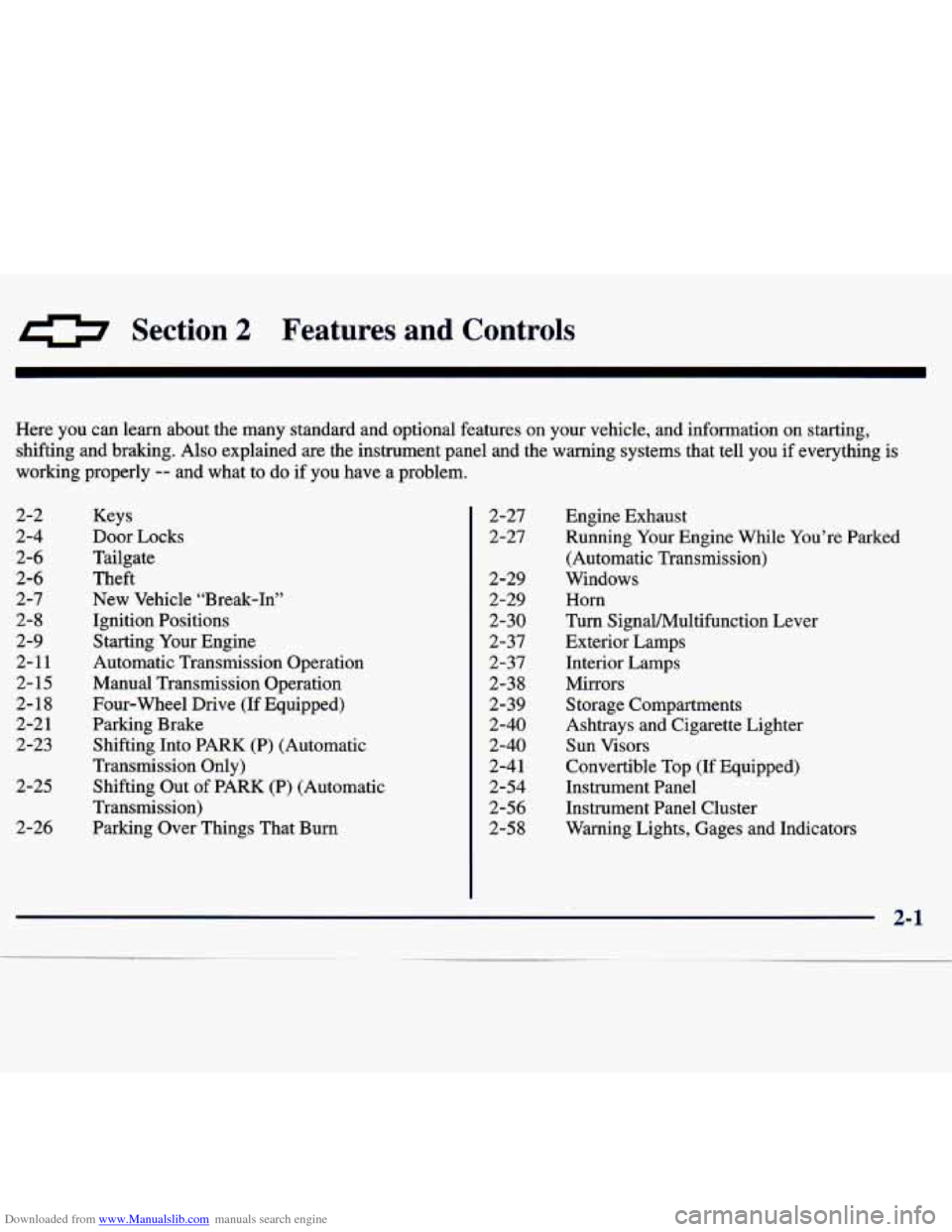
Downloaded from www.Manualslib.com manuals search engine e Section 2 Features and Controls
Here you can learn about the many standard and optional features on your vehicle, and information on starting,
shifting and braking. Also explained are the instrument panel a\
nd the warning systems that tell you if everything is
working properly
-- and what to do if you have a problem.
2-2
2-4
2-6 2-6
2-7
2-8
2-9
2-1
1
2- 15
2-18
2-2
1
2-23
2-25
2-26
Keys
Door Locks Tailgate
Theft
New Vehicle “Break-In”
Ignition Positions Starting Your Engine
Automatic Transmission Operation
Manual Transmission Operation
Four-wheel Drive (If Equipped)
Parking Brake
Shifting Into PARK (P) (Automatic
Transmission Only) Shifting Out
of PARK (P) (Automatic
Transmission)
Parking Over Things That Burn
2-27
2-27
2-29
2-29
2-30
2-37
2-37
2-38
2-39
2-40
2-40
2-4
1
2-54
2-56
2-58
Engine Exhaust
Running Your Engine While You’re Parked
(Automatic Transmission)
Windows
Horn
Turn SignaYMultifunction Lever
Exterior Lamps
Interior Lamps Mirrors Storage Compartments
Ashtrays and Cigarette Lighter
Sun Visors
Convertible Top (If Equipped)
Instrument Panel
Instrument Panel Cluster
Warning Lights, Gages and Indicators
Page 61 of 386

Downloaded from www.Manualslib.com manuals search engine Keys
' /1 CAUTION:
I
Leaving young children in a vehicle with the ignition key
is dangerous for many reasons.
A child or others could be badly injured or
even killed.
They could operate power windows or other
controls or even make the vehicle move. Don't
leave the keys in a vehicle with young children.
2-2
Page 62 of 386
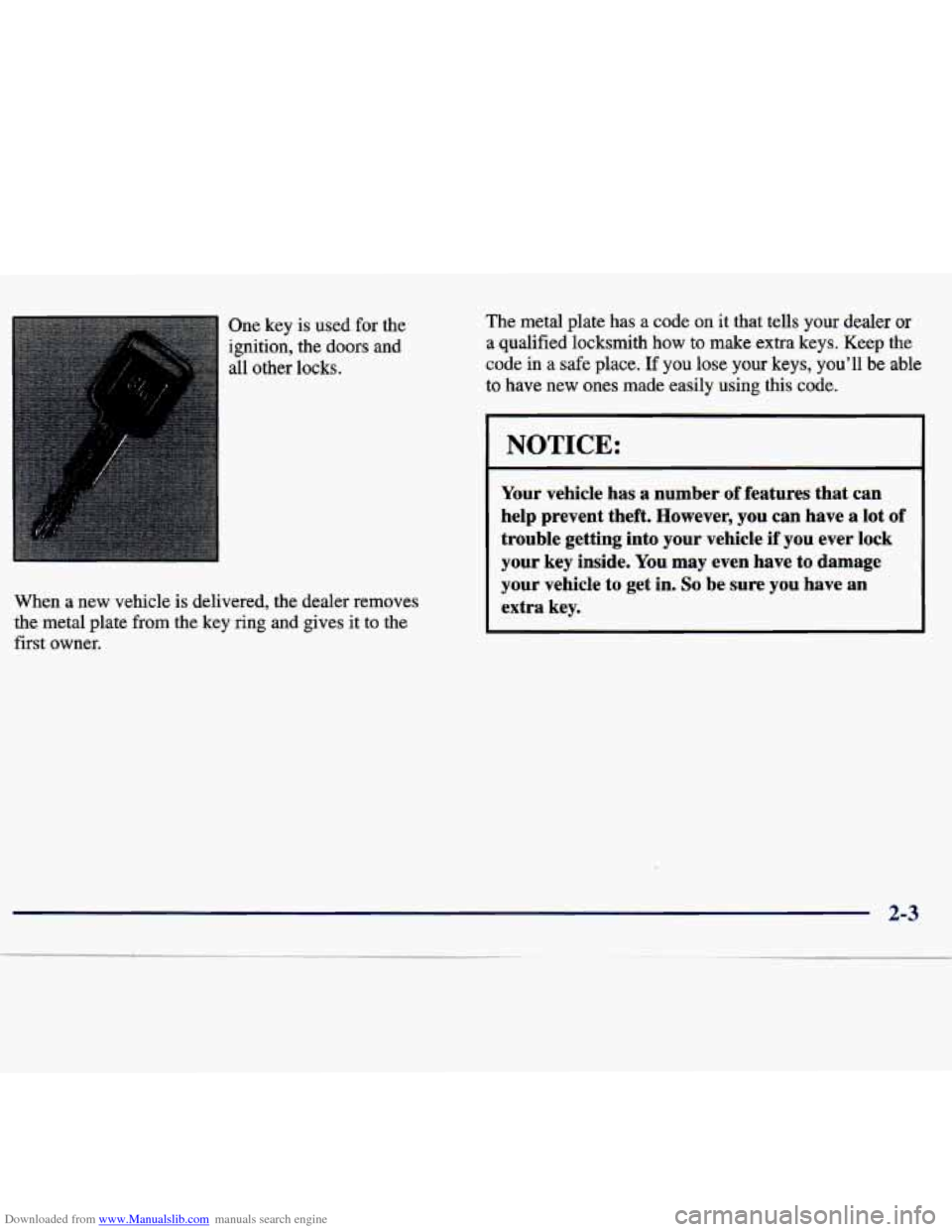
Downloaded from www.Manualslib.com manuals search engine One key is used for the
ignition, the doors
and
all other locks.
When a new vehicle
is delivered, the dealer removes
the metal plate from the key ring and gives it to the
first owner. The
metal plate has
a code on it that tells your dealer or
a qualified locksmith how
to make extra keys. Keep the
code in a safe place.
If you lose your keys, you’ll be able
1 :o have new ones made easily using this code.
NOTICE:
Your vehicle has a number of features that can
help prevent theft. However, you can have a lot
of
trouble getting into your vehicle if you ever lock
your key inside.
You may even have to damage
your vehicle to get in.
So be sure you have an
extra key.
Page 63 of 386
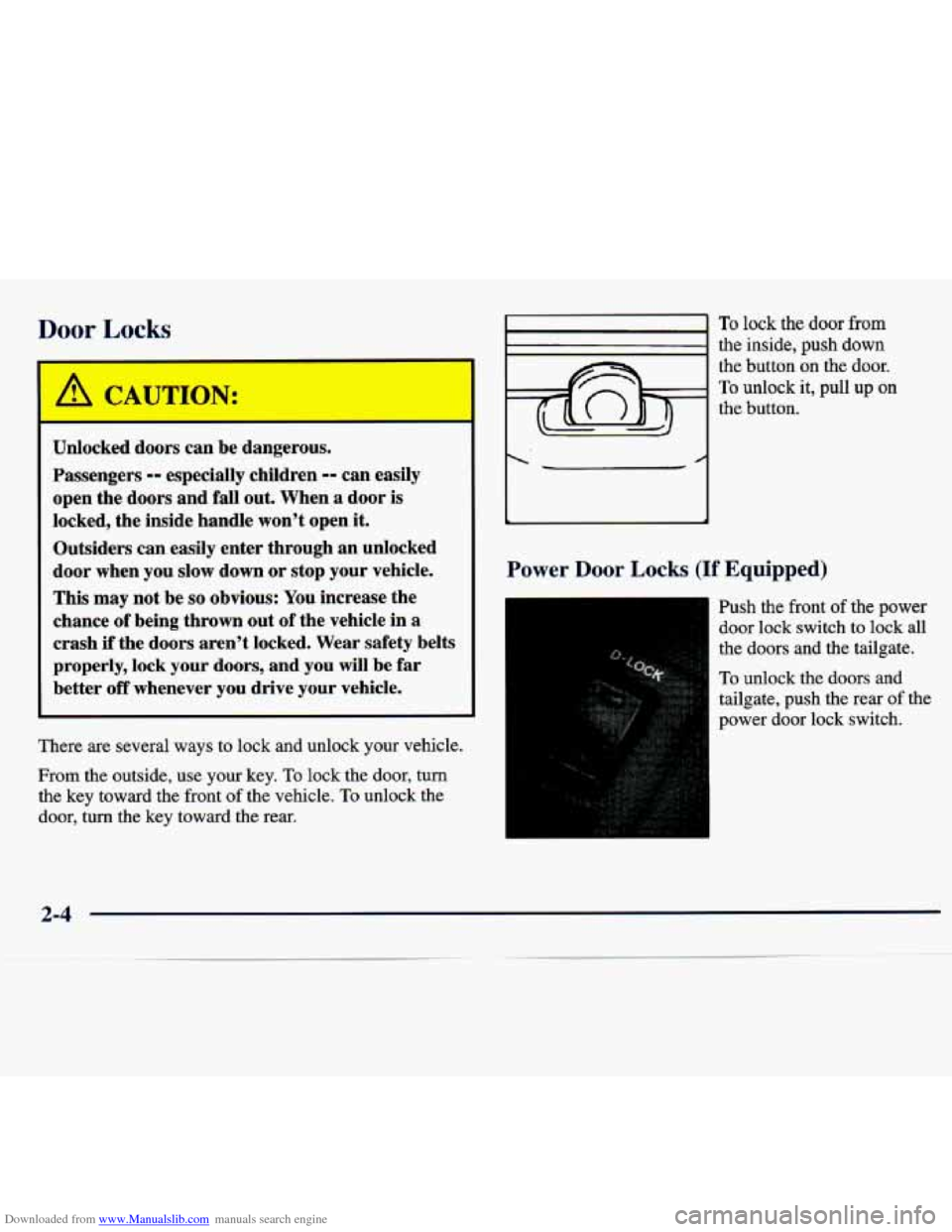
Downloaded from www.Manualslib.com manuals search engine Door Locks
Unlocked doors can be dangerous.
Passengers
-- especially children -- can easily
open the doors and fall out. When
a door is
locked, the inside handle won’t open it.
Outsiders can easily enter through an unlocked
door when you slow down or stop your vehicle.
This may not be
so obvious: You increase the
chance of being thrown out of the vehicle in
a
crash if the doors aren’t locked. Wear safety belts
properly, lock your doors, and you will be far
better
off whenever you drive your vehicle.
There are several
ways to lock and unlock your vehicle.
From the outside, use your key.
To lock the door, turn
the key toward the front of the vehicle.
To unlock the
door, turn the key toward the rear.
1
To lock the door from
the inside, push down
the button on the door.
To unlock it, pull up on
the button.
Power Door Locks (If Equipped)
Push the front of the power
door lock switch to lock all
the doors and the tailgate.
To unlock the doors and
tailgate, push the rear of the
power door lock switch.
2-4
Page 64 of 386
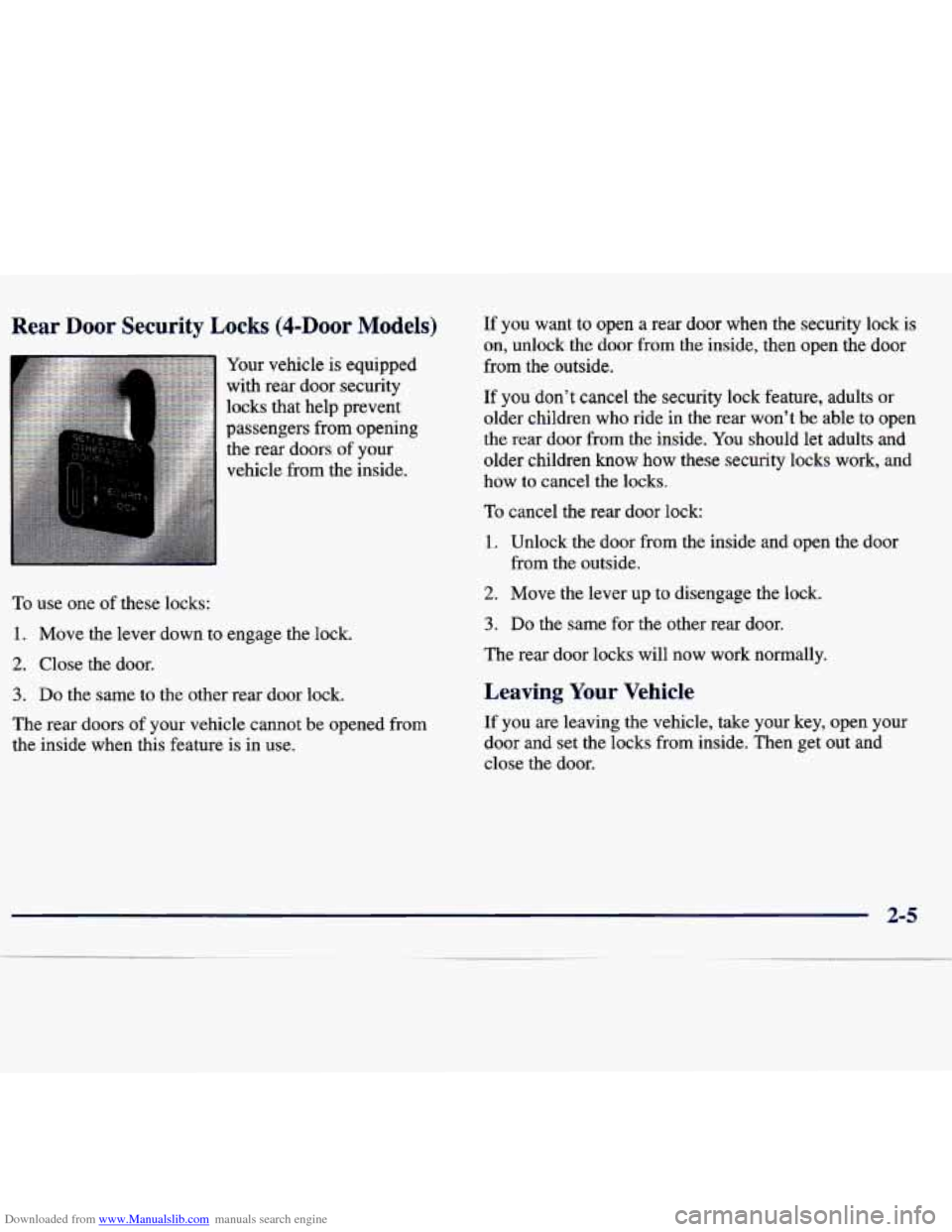
Downloaded from www.Manualslib.com manuals search engine Rear Door Security Locks (4-DOOr Models)
Your vehicle is equipped
with rear door security
locks that help prevent
passengers from opening
the rear doors of your
vehicle from the inside.
To use one of these locks:
1. Move the lever down to engage the lock.
2. Close the door.
3. Do the same to the other rear door lock.
The rear doors of your vehicle cannot be opened from
the inside when this feature is in use. If
you want to open a rear door when the security
lock is
on, unlock the door from the inside, then open the door
from the outside.
If you
don’t cancel the security lock feature, adults or
older children who ride in the rear won’t be able to open
the rear door from the inside.
You should let adults and
older children know how these security locks work, and
how to cancel the locks.
To cancel the rear door lock:
1. Unlock the door from the inside and open the door
from the outside.
2. Move the lever up to disengage the lock.
3. Do the same for the other rear door.
The rear door locks will now work normally.
Leaving Your Vehicle
If you are leaving the vehicle, take your key, open your
door and set the locks from inside. Then get
out and
close the door.
2-5
Page 65 of 386
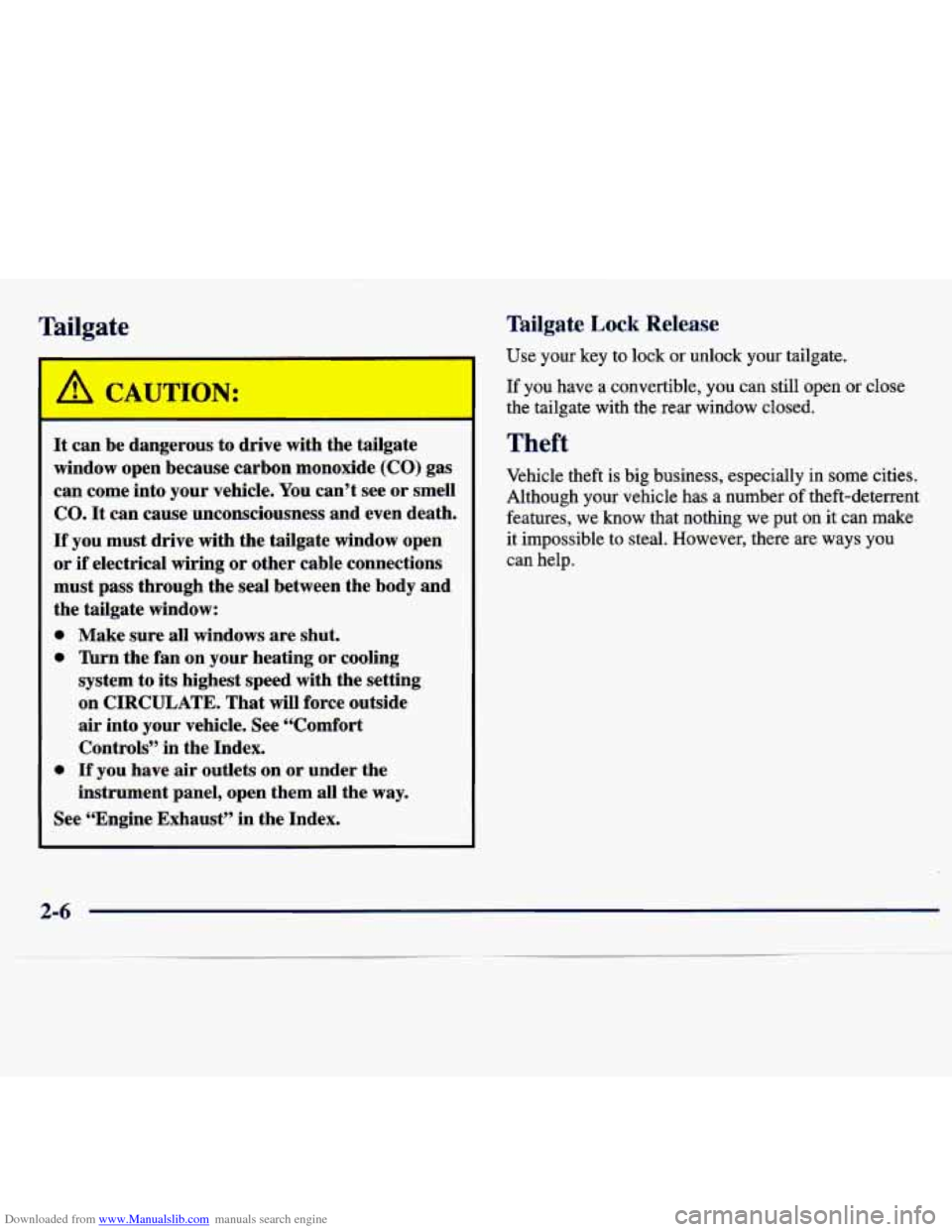
Downloaded from www.Manualslib.com manuals search engine Tailgate
It can be dangerous to drive with the tailgate
window open because carbon monoxide (CO) gas
can come into your vehicle. You can’t see or smell
CO. It can cause unconsciousness and even death.
If you must drive with the tailgate window open
or
if electrical wiring or other cable connections
must pass through the seal between the body and
the tailgate window:
0 Make sure all windows are shut.
0 ’hrn the fan on your heating or cooling
system to its highest speed with the setting
on CIRCULATE. That will force outside
air into your vehicle. See “Comfort
Controls” in the Index.
0 If you have air outlets on or under the
instrument panel, open them all the way.
See “Engine Exhaust” in the Index.
Tailgate Lock Release
Use your key to lock or unlock your tailgate.
If you have a convertible, you can still open
or close
the tailgate with the rear window
closed.
Theft
Vehicle theft is big business, especially in some cities.
Although
your vehicle has a number of theft-deterrent
features, we know that nothing we put on
it can make
it impossible to steal. However, there are ways
you
can help.
2-6
Page 66 of 386
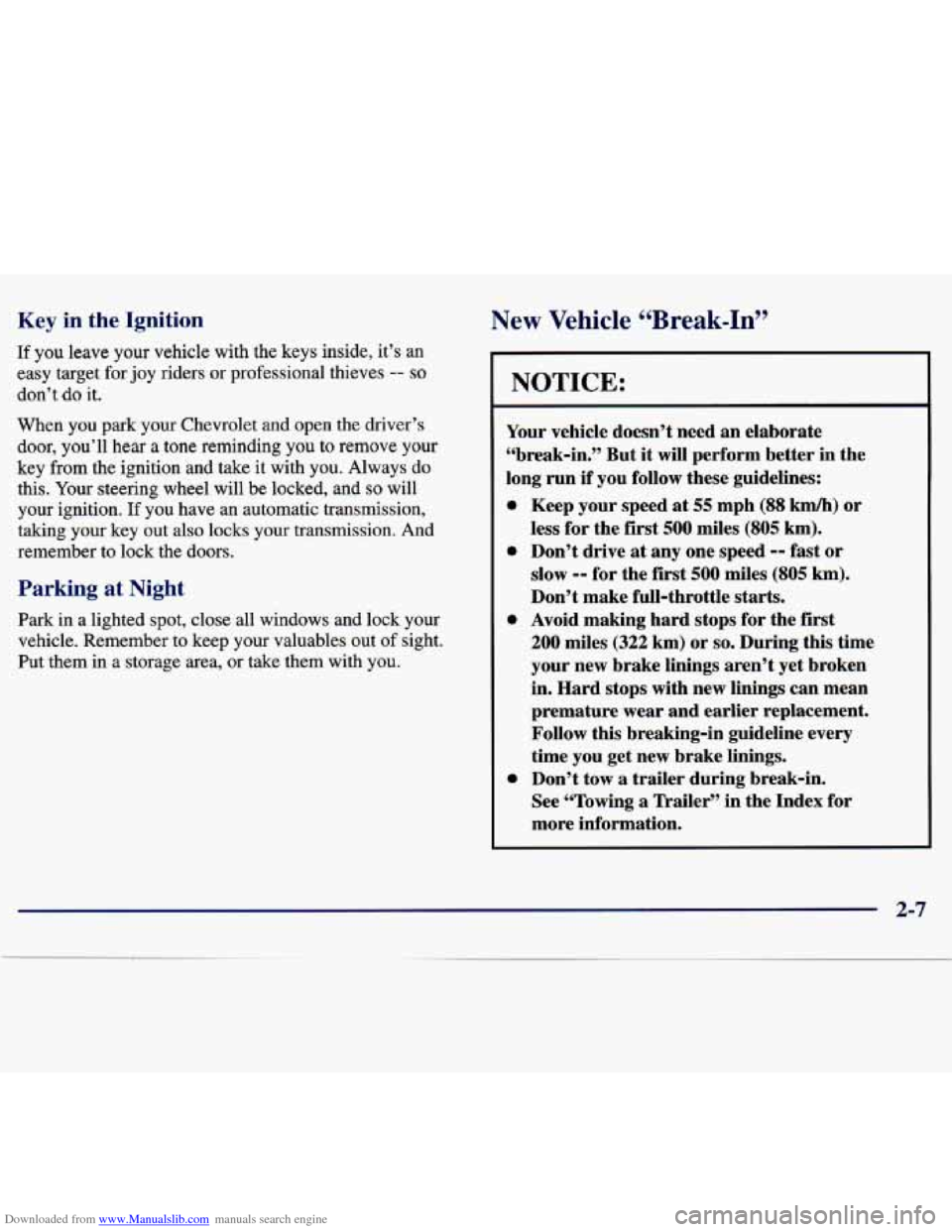
Downloaded from www.Manualslib.com manuals search engine Key in the Ignition
If you leave your vehicle with the keys inside, it’s an
easy target
for joy riders or professional thieves -- so
don’t do it.
When you park your Chevrolet and open the driver’s
door, you’ll hear a tone reminding you to remove your
key
from the ignition and take it with you. Always do
this. Your steering wheel will be locked, and so will
your ignition.
If you have an automatic transmission,
taking your key out also locks your transmission. And
remember
to lock the doors.
Parking at Night
Park in a lighted spot, close all windows and lock your
vehicle. Remember to keep your valuables out
of sight.
Put them in a storage area, or take them with
you.
New Vehicle ccBreak-InSS
NOTICE:
Your vehicle doesn’t need an elaborate
“break-in.)’ But
it will perform better in the
long run
if you follow these guidelines:
0
0
0
0
Keep your speed at 55 mph (88 kmh) or
less for the first 500 miles (805 km).
Don’t drive
at any one speed -- fast or
slow -- for the first 500 miles (805 km).
Don’t make full-throttle starts.
Avoid making hard stops for the
first
200 miles (322 km) or so. During this time
your new brake linings aren’t yet broken
in. Hard stops with new linings can mean
premature wear and earlier replacement.
Follow this breaking-in guideline every
time you get new brake linings.
Don’t tow
a trailer during break-in.
See “Towing
a Trailer” in the Index for
more information.
2-7
Page 67 of 386
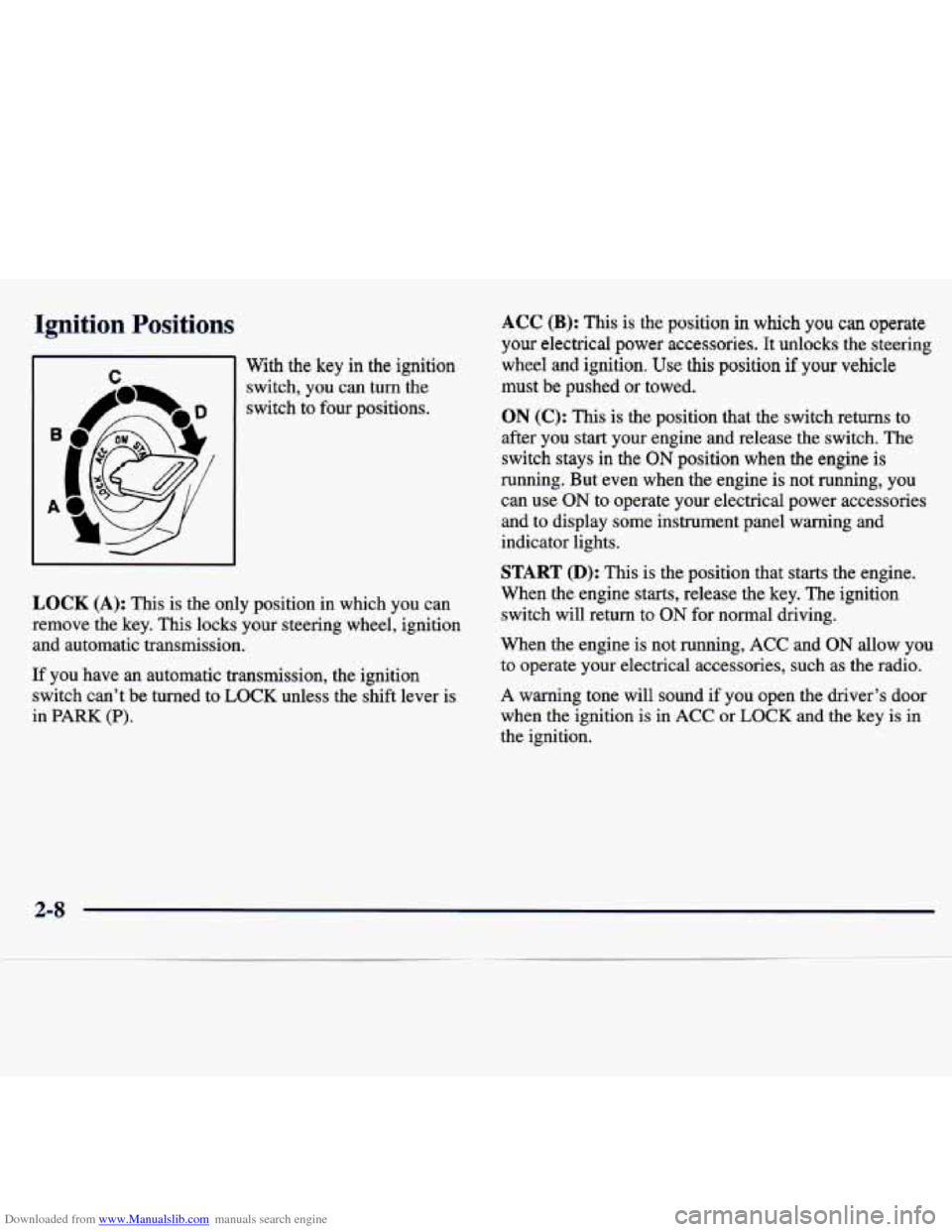
Downloaded from www.Manualslib.com manuals search engine Ignition Positions
m I With the key in the ignition
rr
4 I
switch, you can turn the
switch to four positions.
LOCK (A): This is the only position in which you can
remove the key. This locks your steering wheel, ignition and automatic transmission.
If you have
an automatic transmission, the ignition
switch can’t be turned to
LOCK unless the shift lever is
in
PARK (P).
ACC (B): This is the position in which you can operate
your electrical power accessories. It unlocks the steering
wheel and ignition. Use this position
if your vehicle
must be pushed or towed.
ON (C): This is the position that the switch returns to
after you start your engine and release the switch. The
switch stays in the
ON position when the engine is
running. But even when
the engine is not running, you
can use
ON to operate your electrical power accessories
and
to display some instrument panel warning and
indicator lights.
START (D): This is the position that starts the engine.
When the engine starts, release the key. The ignition
switch will return to
ON for normal driving.
When the engine is not running,
ACC and ON allow you
to operate your electrical accessories, such as the radio.
A warning tone will sound if you open the driver’s door
when the ignition is in
ACC or LOCK and the key is in
the ignition.
2-8